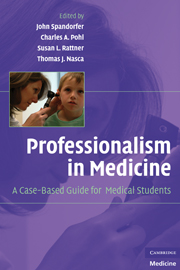1 - Defining, Teaching, and Learning Professionalism
Published online by Cambridge University Press: 25 February 2010
Summary
Professionalism is frequently described as the fundamental core of medicine. This chapter discusses the importance of professionalism, its historical contexts, the current challenges, and the Physician Charter as a worldwide medical response to these challenges. The chapter also examines and elaborates on other definitions of professionalism, explores how professionalism is acquired and strengthened, and summarizes current medical education approaches to promoting professionalism.
PROFESSIONALISM TODAY
Why Is Professionalism Important?
The Physician Charter avers in its preamble that “professionalism is the basis of medicine's contract with society.” This pact or agreement denotes a reciprocal, though tacit, relationship between the public and the medical profession. The public gives physicians rights and privileges in return for their adherence to values that enable them to protect the public health, which is vital to the very existence of society itself. That is, in exchange for authority to control key aspects of their working conditions, the public expects physicians to maintain high standards of competence and moral responsibility. According to the Charter, trust is essential to this contract. Public trust depends on whether the actions of physicians and their leaders demonstrate the values of medical professionalism.
Why Is Professionalism Increasingly Important?
Healers across time and cultures have embraced the values of professionalism. Derived from the need to care for the sick, professionalism in Western societies expanded in Hellenic Greece to include service and in medieval England to include obligations to society and individual patients.
- Type
- Chapter
- Information
- Professionalism in MedicineA Case-Based Guide for Medical Students, pp. 7 - 22Publisher: Cambridge University PressPrint publication year: 2009

